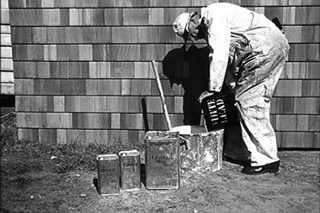
Awards
DJC.COM
June 25, 2009
MBA marks a century of building community
MBA of King and Snohomish Counties

Klusman
|

Workhoven
|
Their conversation would have been punctuated by the noise of streetcars and horse-drawn carriages from the street below. The smell of pomade and mustache wax would have mingled with cigar smoke. But their conversation would have continued — after 20 years of unprecedented growth, what was next?
The year was 1909 and five builders met on an August night in the newly completed Central Building to discuss the burgeoning home building industry and its many challenges and opportunities. The population of the cities of Everett and Seattle had tripled in the previous decade and Seattle was now “on the map” with its Alaska-Yukon-Pacific Exposition.
There were few building codes or restrictions on land use, and builders raced to build homes to keep up with demand. The builders that met that night understood that it was vital to create safe standards and practices for their burgeoning industry. The industry suffered from a lack of coordination between builders, subcontractors and suppliers. They knew that they needed to work together to ensure the viability of a growing industry that to this day provides a fundamental human need: shelter.

Photo courtesy of MBA of King and Snohomish Counties In the old days, workers mixed toxic ingredients such as lead into their paint. |
Over the next five years, as these builders formed the nation’s first home builders association, standards and a code of ethics were adopted. But the development from frontier boomtown dependent on logging, fishing and mining to a growing city where factories and steamships replaced mud flats was not always smooth.
Boom and bust
Soon after the Master Builders Association was founded, its members faced an enormous challenge. Seattle would lose $200 million in World War I contracts unless it could provide suitable housing for the influx of war workers. A five-day campaign secured pledges from builders to construct 3,650 new homes. Amazingly 2,000 homes were completed in just the first two months and Seattle manufacturers kept their contracts.
After the war, many of the workers stayed in the area, but the rosy predictions for the Puget Sound area in the 1920s never materialized. Economic stagnation hit the industrial and manufacturing sectors hard and our region became more dependent on mining and logging as well as agriculture.
In late October of 1929, a series of stock collapses triggered the Great Depression, which devastated home building and brought the nation to its knees. Unable to make their mortgage payments, destitute families congregated in ramshackle communities that came to be known as “Hoovervilles” after President Herbert Hoover. Hoover was viewed as uncaring by many for his insistence that a free market would correct the economic woes of the time.
It didn’t. Between 1929 and 1933, home building fell by 95 percent. Home repair and remodeling went from a $500 million per year industry to $50 million. Most Americans, locally and nationally, were renters.
In the 1930s, most mortgages were short term, only three to five years long, and there were no refinancing or deferred payment options. You made the payment or you were evicted. As unemployment went from single digits to double digits and then soared to 25 percent, many unemployed borrowers simply couldn’t make their payments. Banks began foreclosing on homes at a record rate — nearly 1,000 per day at its worst point. By the end of 1932, a total of 237,000 homes had been foreclosed in the greater Seattle area.
MBA hangs on
Membership in the Master Builders peaked at more than 60 in the early 1930s, thanks to the efforts 25 years earlier by a few early pioneers in local home building such as Edward L. Merritt, whose Craftsman Bungalow Co. created striking showcase homes in Seattle. By 1936, it was a different story: Membership plummeted to seven builders and the association was held together by the gritty determination of builders like Sam Anderson and E.J. Groseclose. By 1939, membership was back up to 60.
But this national disaster would create a new future for home building as the government looked to the construction industry to lead the country out of the depression. The Federal Housing Administration was founded in 1934 and provided just about the only mortgage financing and home repair loans available. Government loans not only allowed home buyers a lower down payment, but extended the term of the loan to 30 years. FHA also allowed builders to buy large tracts of land and ushered in the creation of housing developments.
As the 1930s came to a close, the Master Builders Association teamed up with the Seattle Post-Intelligencer and W.G. McDonald to sponsor the first Seattle Home Show in 1939. It was called the First Annual National Housing Exposition and First Lady Eleanor Roosevelt was on hand for the ceremonial ribbon cutting.
The first Seattle Home Show featured a full-size, low-cost home assembled in Seattle’s Civic Auditorium, completely furnished by Frederick & Nelson. The FHA had mortgage and financing information available.
Seventy years later, the Seattle Home Show still draws tens of thousands of consumers who learn about everything from innovative new products to financing options for buying or remodeling a home. The show continues to be managed by the McDonald family and you’ll find the Master Builders Association and its Remodelors Council booths near the front doors; still handing out advice, information and know-how after all these years.
Boeing’s rise
World War II would bring an end to the Great Depression and change the Puget Sound area in many ways. The significance of the decision by the Royal Air Force and the U.S. Army Air Corps to use Boeing’s B-17 bomber can’t be understated. It was as if it began raining Boeing workers. Employment went from 4,000 employees in 1939 to 30,000 in December of 1941 when the U.S. entered the war, and peaked at 50,000 in 1944. At that time, Boeing accounted for almost half of the entire manufacturing output in Washington state.
Once again the region faced the wartime question: Where will all these workers live? Home builders were desperately needed to build solid and affordable homes quickly and efficiently.
Boeing and home building kept our economy bustling after World War II. In 1947, Boeing employed about one in every five of King County’s manufacturing workers; by 1957 this ratio had increased to approximately one of every two. And every one of those workers needed a home they could afford.
After the Great Depression and the war, there were thousands locally with a steady job, increased credit availability, and a great deal of pent up demand for home ownership.
The burbs
In the late 1940s and 1950s, a new trend emerged: Two-thirds of the new homes in King and Snohomish counties were built outside of Seattle and Everett. Fifteen major firms were responsible for much of the development of the larger housing concentrations in the early and mid-1950s. Entire new suburbs sprung up. The Eastside expanded, thanks in part to the newly completed floating bridges over Lake Washington. And in southern Snohomish County, suburbs such as Mountlake Terrace sprouted up.
Congestion, demand for better transportation and infrastructure, and new government regulations were quick to follow. The Master Builders Association realized it needed to have its voice heard in the local and state legislatures and became an advocate for job-site safety and consumer product safety.
In the late 1950s, sliding glass doors were an exciting innovation for the home. But many builders referred to them as “guillotine glass” because of the serious injuries people suffered when accidentally walking into them. The Master Builders Association flew experts from Owens-Corning and Pittsburgh Glass to Seattle to test and improve their glass products and pushed through the first legislation in the country to mandate the use of safety glass.
For years Boeing’s success kept Seattle’s economy booming. But after demand for Boeing’s 747 fell far short of expectations in 1970 and 1971, the economy sputtered. Two real estate agents (and Master Builders Association members) captured the humor and undefeatable spirit of the Pacific Northwest with their iconic billboard with the catch phrase: “Will the last person leaving Seattle turn out the lights.”
In an effort to inspire consumer confidence, the Master Builders Association promoted the benefits of home ownership, worked to help lift moratoriums on state and federal projects and adopted the home owners warranty program, one of the first new home warranties in the nation.
Regulation riptide
The last three decades of the 20th century were dominated by a series of issues: land use, growth management, energy conservation and environmental protection. During this 30-year period, a riptide of government regulations were imposed at the local, state and federal levels, controlling how housing is constructed; where it is built; how dense it is; and the fees and taxes imposed on builders to pay for roads, schools and other off-site public infrastructure. Suddenly, the impact of home building on the environment was hotly debated.
A few examples include:
• The State Environmental Policy Act, first adopted in 1971, created an environmental review process that dramatically shifted how housing is developed to this day.
• Passage of the federal Clean Water Act eventually led to a host of regulations governing stormwater runoff from construction sites.
• The Growth Management Act of 1990 was a turning point in land-use regulation in our state, establishing urban growth areas and directing counties to create comprehensive plans.
Eventually, Master Builders Association members shifted their stance away from resisting GMA to one of trying to work with local governments to make the law work better. Overall, when it comes to the environment, the Master Builders Association has worked very hard to strike the right balance between protecting the environment and supporting the need to accommodate a range of housing types.
Having a clean and healthy environment is part of what makes our area a desirable place to live. Our efforts as an association have been directed toward being part of the solution for our region.
As it has for 100 years, the Master Builders Association continues to stand at the forefront of the building industry. MBA University provides continuing education in everything from safety and project management to real estate sales, marketing and environmental construction.
The Master Builders’ commitment to its original code of ethics has led to the development of the highly successful environmental building and remodeling program, Built Green, as well as the creation of two nonprofit foundations: Master Builders Care Foundation, which works with local nonprofits to build and maintain homeless shelters and special services like building wheelchair access ramps for low-income individuals, and the Master Builders Career Connection, which is a workforce development program.
This year, to celebrate our 100-year anniversary, we’re honoring the men and woman of the local home building industry who have built, remodeled and maintained countless homes in our region.
We’re also celebrating by giving back to the community. During our centennial year, Master Builders Association members are performing 100 community service projects. We’ve been collecting food for food banks, maintaining shelters for the homeless, and this summer we’ll break ground on a new wet lab at the Mercer Slough Environmental Education Center.
And with that same dedication, innovation and commitment to quality, the Master Builders Association looks forward to the next 100 years of building the communities we call home.
Dan Klusman is communications director and Melanie Workhoven is a communications manger at the Master Builders Association of King and Snohomish Counties.
Other Stories:
- Educating tomorrow’s construction workforce
- How did we get into the housing crisis?
- Builders contribute more to the local economy than you might think
- MBA marks 100 years with 100 community projects
- What Built Green is and why you should care
- A heightened learning experience
Copyright ©2009 Seattle Daily Journal and DJC.COM.
Comments? Questions? Contact us.